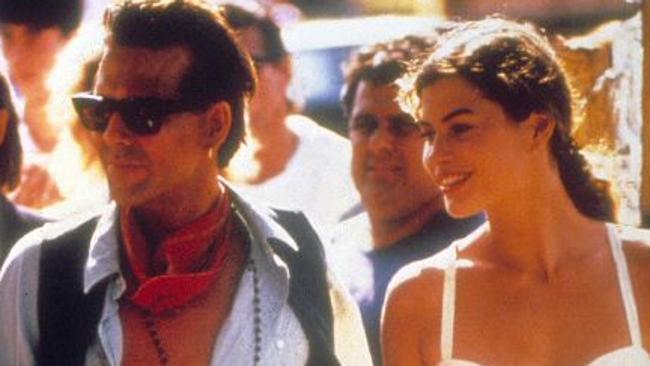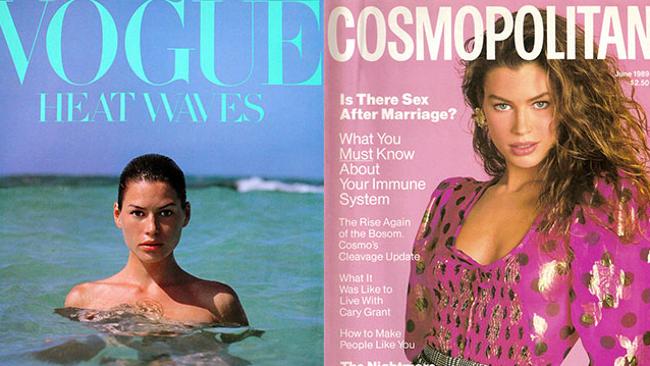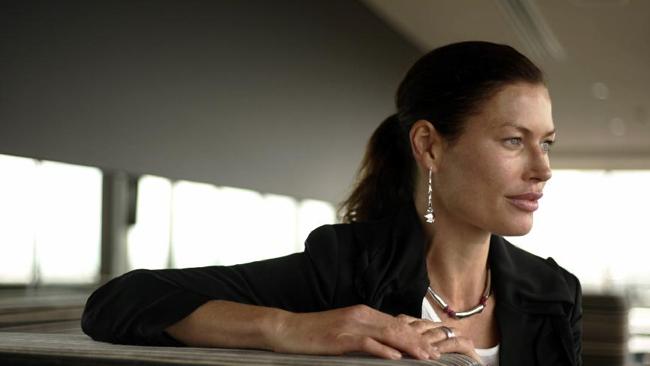
© News Limited Network Carre Otis with Mickey Rourke in 1989.
Think models are effortlessly perfect glamour magnets lapping up the good life?
US model Carre Otis lets
Vogue in on the truth about
airbrushing, starvation, yellow teeth and sexual abuse...When I was 18 and arriving on the modelling scene in the mid-80s, attention from the public felt sudden and surprising. After working so hard as a teenager in both Europe and the States, after so many rejections and failed "gosees"(castings), after the countless not-so-subtle suggestions from industry professionals that I just might not have "it", I was shocked when others started following my career. When I visited my agents, they'd hand me a stack of letters and I'd look over my shoulder, wondering if it was intended for the actual famous models in the other room. "Carr.," my agent said, her hands firmly planted on my shoulders, "You're a celebrity now. Get used to it." There were some kind letters, praising the art direction or aesthetics of a photo shoot. And there were some filthy ones in which men detailed what they'd like to do to my body and - equally upsetting - what they did to their own while staring at my image. Despite some of the more alarming aspects of the latter type, I was mostly flattered that by posing for a picture I had inspired absolute strangers to take time out and send me their thoughts.
But there was one type of letter that consistently left me uneasy: the type that made up about 80 per cent of my fan mail. It was the one from the young girl in the age range of 10 to 15, seeking my advice about how to become what I was only pretending to be.
They wanted my tips and my beauty "secrets".
But I wasn't willing to reveal the real secrets: the destructive behaviours and inner torment. I was keeping those secrets not only from my earnest fans but from myself as well. So I'd just send them an autographed photo and hope that by avoiding answering the questions I could avoid facing my own dark reality.
I recently came across a box filled with some of these very letters. And while I can't go back in time to answer those young girls, I hope to provide some insight by answering them now. Below are the answers I didn't have the nerve to give then.
"Dear Carré,I'm 10. What is your workout routine and what do you eat? I wish I had your body. What's it like to look like that? I would die to look like you."Whenever asked about my diet/workout, I would cite a healthy routine, the kind touted in women's magazines. "Jazzercise three times a week and light weights," I'd say. The heavily guarded truth was that I exercised a minimum of two hours a day, seven days a week. On days when I wasn't working, I did double duty, going to the gym twice in one day. I said I ate oatmeal for breakfast, chicken and veggies for lunch, and fish and salad for dinner, along with a healthy snack like yoghurt. But in reality, my big diet staple was four to six cups of black coffee per day, avoiding even a splash of skim milk since I was terrified of extra calories. And to stave off hunger, I went through a few packs of cigarettes daily. Cigarettes with coffee gave me an energy boost. And all energy boosts were welcome because
my body was perpetually fatigued from little to no sleep, over-exercised muscles, starvation and the relentless stream of criticisms inside my own head.

© SuppliedCarre Otis, covergirl.
I made sure nobody knew about my real routine, protecting it fiercely so that I could maintain a body that nature simply did not intend for me to have. When I got especially skinny I got lots of positive reinforcement: more compliments and more jobs. Due to the stimulants of nicotine and caffeine, and the gnawing hunger pains, I rarely slept. Even when I tried to lie down I was jacked up and restless, barely able to shut my eyes. So I took pills to sleep. What a gnarly existence. So many vicious cycles they're impossible to trace. I slept about an hour a night. But sometimes I was so tired from partying, jet lag and an utter lack of nutrition, that I'd stay asleep for 15 hours straight. As you can see, insecurity and the endless desire to look perfect were the only consistent things in my life.
Models have no union representation, so neither breaks nor meals were common. But if someone ever did take my food order, I was too petrified to eat, imagining that even a salad would bloat me. "No, thanks," I'd say, sipping my coffee. "I just ate." Or I'd order something "sensible" and when it arrived I wouldn't touch it. My teeth gradually yellowed from all the coffee, nicotine and worn enamel caused by bile (from stomach acidity due to all the starvation and even vomiting). But thanks to the brightening whitening power of airbrushing, in every shot my fake smile revealed sparkling teeth.
Without my on-set manicures and pedicures, you'd have seen that, just like my teeth, my nails were breaking and yellow.One morning, I was sent to the emergency room with heart palpitations and an irregular heartbeat - a culmination of 20 years of starvation.
Turns out I'd created three holes in my heart and I needed an emergency ablation surgery. In your letter you said you'd "die to look like [me]". Well that's almost what I did. What did it feel like to look like that, you ask? It felt, quite literally, like heartbreak.
"Dear Carré,I wanted to say that your hair is so shiny and full. How do you care for your hair? I would like your tips so my hair can look just like yours! (By the way, I'm 13.)"It's funny my hair looked so "shiny and full". Because it was actually very dry and brittle from being teased and blown out every day at shoots where I'd pose for hours under blazing hot lights. Since I wasn't eating enough I'd lose lots of my hair in my brush and in the shower. In fact,
sometimes the hairstylists had to pin extra pieces of fake hair to my head or give me wigs just to compensate for what wasn't on my head.In terms of product, I used whatever was in the hotel bathroom. But if I ever got a contract for a shampoo, then I'd lie to everyone and tell them that the only shampoo I'd ever liked and used.
"Dear Carré,I wish I could flirt with boys the way you flirt with the camera. I bet you could have any guy in the world. What does that feel like? I'm 15 and I would die to be that sexy so that boys would like me. Any tips?"I just stared at the camera and pretended I was confident and happy. But right beneath the surface I was overwhelmed by opposite feelings: scared and very, very sad.
I knew how to smoulder for the camera but it was all a defence, a performance covering up the shame and insecurity that stemmed from multiple incidents of sexual trauma and abuse. My boyfriend and I hadn't had sex in months and when we did I faked an orgasm - faking sexual satisfaction just like I faked sexiness for the camera. I sure fooled him, and you.
"Dear Carré,You are my inspiration. You look so cool in your pictures. How can I be cool like you?"Cool. You can credit my frosty stare and the occasional leather jacket. My "cool" lifestyle had me hanging around people who liked to carry firearms and one of them accidentally shot me. It wasn't very cool to be in the emergency room clinging to life. During the majority of my "cool" photo shoots I was worrying that my boyfriend was cheating on me while simultaneously planning what foods I could eliminate from my diet to lose another five pounds in order to a) keep my boyfriend around and b) book another job. "You look beautiful Carr.!" the photographer would yell with every click of the camera. "This is your moment!" But it never felt like my moment. It felt like everyone else's. There I was, supposedly a successful model, but I didn't know how to manage my professional identity, let alone my personal one. Just days after shooting what would one day be known as my most iconic ad, I ended up in hospital, a bullet having just missed my heart. That's when I realised that being alive trumped being "cool" any day of the week.
"Dear Carré,I want your wardrobe. Where do you shop and do you have any suggestions for how I can look better in my clothes?"The clothes you saw me in either belonged to the magazines or the designers who made them. They were selected by stylists, not by me. (And those clothes could be painfully tight! They were usually pinned in the back so that they'd fit right and it didn't matter that the pins dug into my skin. Just one of many unglamorous tricks of the trade.)
If you got a peek into my closet, you'd quickly realise I didn't have a clue about fashion. I was a hippie chick who bought clothes from flea markets. To this day, I don't even know how to pronounce "haute couture", let alone shop for it.
Even if I had any desire to wear those clothes in real life, for the majority of my career I couldn't have afforded them anyway. The only reason I might own any high-fashion outfit was if it had been given to me by a designer in exchange for my walking his/ her runway show. But clothing - no matter how fancy - didn't pay the bills.
So, how can you look better in your clothes, you ask? By now you know I'm no expert but I can tell you what works for me today: comfortable fabrics that feel good on my skin and pretty colours that lift my mood. If an ad or photo spread inspires you, great. But be careful about comparing yourself to those models. Plenty of them are like me. They know nothing about the must-have seasonal trends. They are - like I was - paid to be a clothes-hanger.
"Dear Carré,Your skin is flawless! I'm 14 years old and I have so many pimples. I hate them! How can I get perfect skin like yours?"My "flawless" skin was only flawless in pictures, thanks to a whole lot of air-brushing. If you saw my face in real life you'd have seen pimples, dry patches and rashes, all consequences of constant flying, dehydration, lack of nutrition, stress, cigarettes, heavy make-up and sleep deprivation.
So you have pimples? Welcome to the club. How can you get "perfect" skin like mine? Good question. Do you know any good air-brushers?"Dear Carré,What's it like to live such a glamorous lifestyle? Do you have a yacht?"Here's the deal on my so-called "glamorous lifestyle": I never owned a yacht. Or a house even. In fact, some months I couldn't pay the rent on my apartment. I got some great contracts that paid a lot but I spent money frivolously. Then there'd be months of no work. In the earlier days, I'd often give my all on a shoot - 20 hours with no break - but wouldn't see a dime. If the client didn't like my performance then, oh well, my agent didn't hold the client responsible. I was told to suck it up and take it as a learning lesson. Sometimes I wasn't paid because the agency felt I owed them - debts from test shoots, portfolio expenses and hotel rooms.

© SuppliedCarre Otis in 2005
With the exception of a few jobs, there was very little jetsetting. For much of my career I flew coach and when I arrived I was often greeted by, simply put, an asshole, who told me I was too fat, too bloated and too red-eyed to work that day. I mostly stayed in dank hotels with multiple model-roommates. I'd show up to set at dawn and was told to assume crazy positions. "Leap over that sand dune...higher! Now be a happy, sexy fawn!" So leap like a fawn I did, even though I was really just a tired, homesick, hungry girl who wished she could go to the Eiffel Tower or enjoy a croissant at the cafe without calculating calories.
Modelling felt like a constant exercise in shoving aside my real feelings. When I had my period and was moody and bloated, I had to strip down to nearly nothing and look sexy for the camera. When I learnt that my dog back home was hit by a car, I had to shove that grief down and pose like I was on cloud nine. There was no discussion of selfcare, honouring feelings or communicating needs. It was brutal. I can't deny the fact that I had some extraordinary experiences in the industry. After I "made it" I could make more demands and draw more boundaries. But even then I was still part of a reckless and flawed system. I continued, for example, to endure sexual harassment without realising it didn't have to be a job requirement. While there are plenty of models who can say they had mostly wonderful experiences, who thrived both inside and outside the industry, I know that many are still contending with the same obstacles I did - trying to meet impossible standards of perfection and accepting abusive power dynamics as "just part of the job". I've proudly become involved in the Model Alliance, an organisation that takes abuse reports, aggressively challenges the code of silence, and continues the fight for a much-needed models' union. I encourage people to view images of models through a realistic lens, to challenge those automatic assumptions about the internal world of a model based on her (heavily doctored) external appearance.
Today, thankfully, my happiness has nothing to do with my weight or feedback from others. And perfection of any kind is no longer the goal. The notion that perfection can be achieved is a lie we are told and a lie we tell ourselves. That's the ugly truth. I wish I could've told those young fans what I've finally learnt to tell myself: reality - imperfection - is where the real beauty is.
Carré Otis published her memoir, Beauty Disrupted
, in 2011. She is on the advisory board of the Model Alliance and is an ambassador for the National Eating Disorders Association. Otis is currently writing a book about positive body image and nutrition, in addition to co-authoring a book about women's issues and sexual intimacy with writer and clinical psychologist Dr Sarah Spinner.
This article is a real eye-opener to the endemic evil, corruption, and exploitation that is so pervasive in today's world.